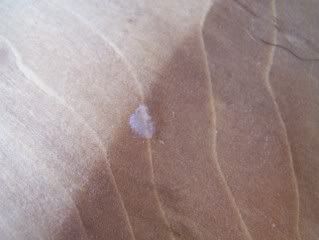A Non Traditional Windsor Finish: Preparing to Dye…
Typically when you see a Windsor chair is has a milk paint finish.  This is because that usually there are multiple species of wood that make up the chair. The tight grain and closed pores of maple or poplar work great for carving out the seat or turning the profiles of the legs and stretchers, but that same tight grain is not good for steam bending the arm or bow of the chair. The closed pores do not allow for any compression space while bending like oak or ash does so that is the primary reason why you find the bent pieces to be some open pored wood.
This is because that usually there are multiple species of wood that make up the chair. The tight grain and closed pores of maple or poplar work great for carving out the seat or turning the profiles of the legs and stretchers, but that same tight grain is not good for steam bending the arm or bow of the chair. The closed pores do not allow for any compression space while bending like oak or ash does so that is the primary reason why you find the bent pieces to be some open pored wood.
Milk paint was the solution to unify those different species and to present a common theme. Lately I have seen a growing number of Windsors with a natural wood finish. Mike Herrel of the Colonial Chair Making Company says that the majority of his customers now request a wood finish over the milk paint. Fortunately, the technological advances in finishing products provide us with much better and more consistent dyes that we can use to unify the varied species in our Windsor chairs.
I recently finished a Windsor chair that I build from scratch. Previously I had taken an abbreviated class where the bending and turning was already done for you. This time I wanted to do the whole thing. Since I have already been turning for several years the legs and front spindles came out nicely using the turning from my first Windsor as a model. The bending was a smooth process and I had no trouble completing the arm and bow. I have done a significant amount of reading on this subject lately and I believe that I had a case of beginners luck this time around since I hear of so many botched attempts when you first get started in steam bending. No arguement from me, but I am cautious of my next attempt because karma may catch up to me eventually. Considering the amount of work and pride I have invested in this chair I want to make sure the finishing stage goes smoothly. I have decided to dye my pieces and apply an oil/varnish topcoat to them.
Before I could even think about adding color to the chair I needed to raise the grain and make sure that I have gotten all the glue spots up that would prevent dye from soaking in. I loaded up an everyday spray bottle with water and completely doused the chair with water. This served two purposes: it will raise the grain as it dries, but it also highlights any glue left over. Boy was I glad I did this because I have glue every where. It shows up on the wet wood as white spots.


 You can see that at just about every joint I had missed some glue. It looks like I am in for a long afternoon of sanding.
You can see that at just about every joint I had missed some glue. It looks like I am in for a long afternoon of sanding.
Finally, aching arms and shoulders, crumpled bits of 220 grit paper everywhere, I brought the chair back into the shop free of glue and with a silky smooth surface.
Now I am exhausted, I’ll put on the dye tomorrow.


